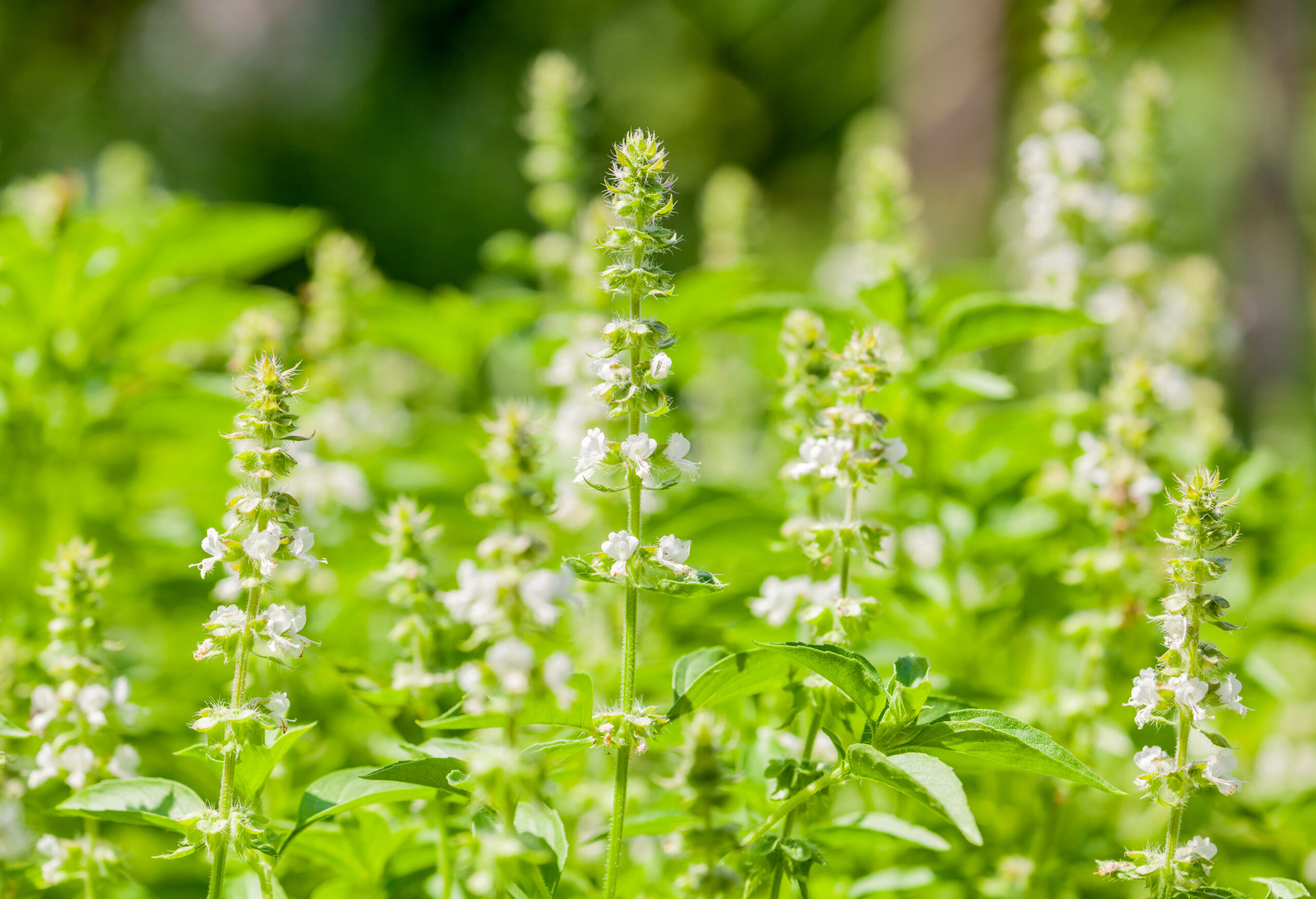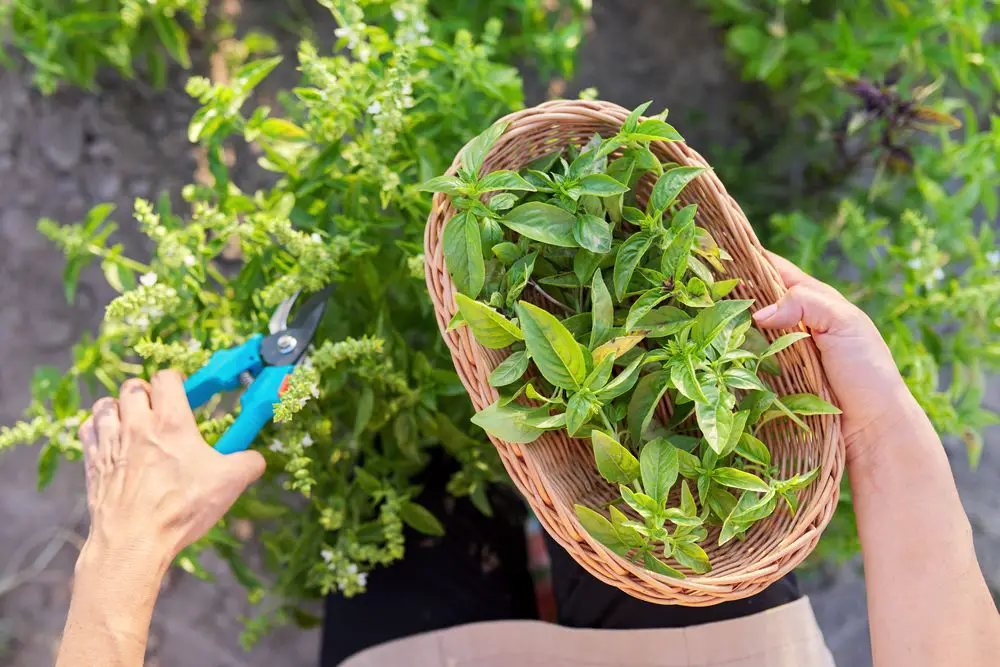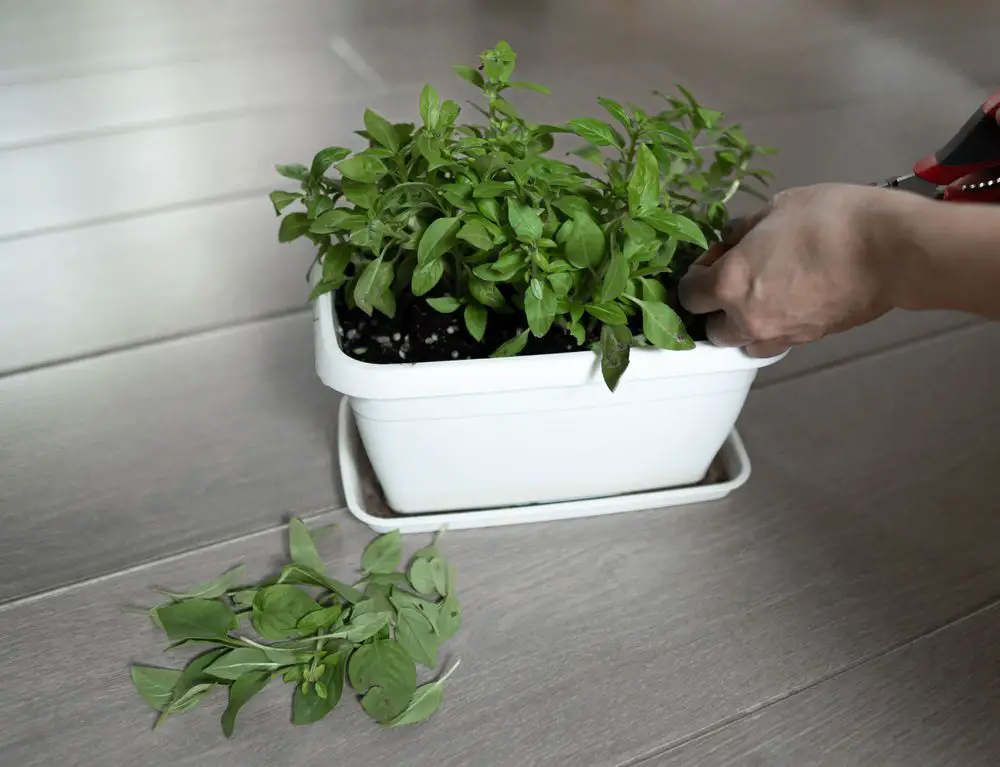Basil plants are often planted because they add a fragrant flavor to dishes. They have medicinal properties, too. It is quite gratifying to cultivate Basil in your yard. Knowing how to trim Basil without killing it is an essential aspect of getting the most out of your plant.
How to prune Basil. Wait for your Basil plant to be at least 6-inch tall, cut the main stem, locate the fifth leaf set, do not cut all the leaves, prune your Basil plant every two to three weeks. Pruning overgrown basil, tips on how to prune a Basil plant without killing it, why you need to prune Basil.

How To Prune Basil: The Correct Way Without Killing the Plant
1. Wait for your Basil Plant to be at Least 6-Inch Tall
Timing is everything for your Basil plant. Your plant will be ready for pruning when it gets to be around 6 inches tall and when it has about 3-4 branches of leaves on its main stem.
Your Basil plant should also have upper and lower sets of leaves.
You are most likely to shorten the life of your plant if you cut it when it is shorter than 6 inches.
2. Cut the Main Stem
The main stem of your Basil plant is where all the branches grow from. The main stem is in the middle part of the plant. It connects the plant to its roots.
You should know which part of the main stem to cut. Look for the leaf sets starting from the top of the plant. There are two branches and two leaves sticking out of the main stem that appears in pairs.
Find the highest point of the main stem and find the first point where the stem splits into two new branches. Cut the main stem above the split.
Pruning the main stem will encourage new growth from the cutting point. Your Basil plant will then grow larger leaves and a fuller plant.
Cutting the main stem will direct the energy of your plant into growing two new stems instead of only the main stem.
Your Basil plant is delicate. You can damage or kill it if you do not carefully cut its main stem. Use a pair of scissors or gardening shears to cut the main stem and not your fingers.
3. Locate The Fifth Leaf Set
Cut about 0.5 inches from the fifth leaf set. Make sure not to cut in a straight line. Position your gardening scissors or pruning shear at an angle. Make sure, too not to cut at the same height as the leaves.
Pinch or cut off individual leaves from the sides of your plant. Remove the leaves at the point where they join the main stem.
4. Do Not Cut All the Leaves
There should be enough leaves left on your Basil plant so it can still produce leaves and branches. Never prune more than 1/3 of the Basil plant at the same time, too.
5. Prune Your Basil Plant Every Two to Three Weeks
After its first major pruning, continue to prune your basil plant every two to three weeks. Always check for flower buds between trimmings. Pinch off the buds before they become flowers.
Prune and harvest your Basil regularly until it dies from the fall frost.
Using your hands to prune your plant is sometimes necessary. It is, however, best to use scissors or garden shears. Using your hands can damage the plant. Besides, you will not be able to get a clean break with your hands.
Your Basil plant is tender and soft. Do not hold it too hard during pruning. Going too hard on your plant can easily rip off its stems and leaves. It can even uproot your plant from the ground.

Pruning Overgrown Basil
- Basil leaves grow quickly and can overgrow in a short time. An overgrown Basil plant is one that is already flowering and, therefore produces leaves that are too sweet for your dishes.
- Although the leaves of overgrown Basil may not be too ideal for cooking, pruning your plant can help enhance and maintain its usefulness and health.
- Cut off dead Basil stalks on the ground.
- Carefully check the stalks and pinch off all wilted leaves. Cut the leaves where the stem of the leaves meets the stalk.
- Remove all flowers from the Basil plant. Start from the Basil stalk with a flower.
- Cut the leaf clusters at the end of the stalk (choose the tallest leaf clusters).
- Save the fresh leaves and dispose of the dead or wilted stems and leaves.
- After trimming your overgrown Basil, prune it regularly. The soil, climate, and weather condition, however, determine how frequent pruning should be done.
Tips on How to Prune a Basil Plant without Killing It
Your Basil plant is generally tender, soft, and easy to trim. Here are some simple tips on how to trim Basil to ensure you do not kill the plant.
- Only cut about 1/3 of the Basil plant at a time. Cutting too many leaves at once may take your plant longer to grow new leaves and longer, too for your plant to grow back.
- Make sure not to trim at least two sets of leaves near the bottom. Your Basil plant will need these leaves to absorb sunlight and produce nutrients. They will also serve as the strong foundation of the plant’s main stem.
- Prune leaves that are growing on the top of the plant. It does not matter if they are still not too large. Removing leaves at the top of your plant allows your plant to grow outwards, bushy, and wide rather than tall.
- Always prune your Basil plant at an angle so it will not bleed and make so much mess.
- Carefully spread the leaves of each branch apart so your pruning shears will not get stuck and cause the other parts of the plant to break.
- Trim only one stem or plant at a time. Pruning more than one stem at a time can damage your plant. Pruning several Basil plants at a time can also damage the plants.
- Trim your Basil plant in an upward motion instead of pushing or slicing it straight down. Cutting upwards means you are cutting above the vascular system of your plant.
- Use gardening shears to trim the main stem and your hands for the leaves.
The most important tip on how to trim Basil is to make sure not to prune too aggressively. Aggressive pruning will not only make your plant grow back quickly, but it may also kill your plant.
It is not difficult to prune your Basil plant. Do it correctly and you can ensure it will grow healthy and continuously supply your kitchen with this herb.
Its delicious leaves are the main reason many people grow Basil. Basil leaves can be used dried or fresh but fresh is so much better than dried.
There are many varieties of Basil, but Sweet Basil is the most common. It is the type of Basil used in making the superb pesto sauce.
Basil is an easy-to-grow herb. You can start growing it indoors or in your garden after the last frost. To ensure the best harvest, give your Basil plant full sun, sufficient water, and regular pruning.
After planting Basil seeds, seedlings start to emerge within five to six days. Basil leaves are delicate, and a slight bruise can release the aroma of its essential oil which dissipates quickly. This makes how to trim Basil leaves with care a necessity.
Your Basil plant can be no taller than 12 inches. Keeping it nicely shaped allows you to enjoy its ornamental and edible features.
If your Basil plant is unhealthy, scrubby, or withers and dies, pruning is most likely where you are going wrong.
You can easily kill your Basil plant if you are pruning it the wrong way. When pruned correctly, your Basil plant will grow more quickly and have more leaves for you to enjoy.
Why You Need to Prune Basil
Pruning means removing or cutting off parts of the plant. These parts are often damaged, diseased, dead, or unproductive. With some plants, however, such as Basil, pruning is the act of harvesting leaves.
To Harvest Basil Leaves
Basil is a good companion plant, but most gardeners grow Basil to get leaves to add to dishes, eat, and make Basil olive oil.
While pruning helps your plant grow healthy, correct pruning produces more tasty Basil leaves.
To Prevent Flowering
Your Basil plant will grow flowers if you do not prune regularly. Your Basil plant will first have green buds and tiny white flowers. Some Basil flowers are lilac or pink.
When your Basil plant starts producing flowers, it means your plant is beginning to die.
All the energy of your Basil plant is diverted to its flowers instead of creating new leaves.
Pruning prevents flowering and allows your Basil plant to produce more leaves. When your Basil plant produces flowers, the leaves lose their flavor. Thus, to ensure an appetising herb, prune your plant regularly to prevent it from producing flowers.
To Ensure a Bountiful Harvest
You do not need to prune your Basil plant, but pruning will ensure you have a bountiful harvest. Pruning will also make your Basil plant live longer.
To Make your Plant Bushy
Each time you prune your Basil plant, you are allowing it to grow two new branches from the spot that you pruned.
These new branches will grow new sets of leaves. When you prune again, your plant will again grow new branches and new sets of leaves.
This means that much of the growing success of your Basil plant is dependent on pruning.
Regularly trimming the tops of the stems of your Basil plant will make it bushy, grow more leaves, and prevent your plant from growing flowers.
Pruning your Basil plant doubles the number of leaves produced on the stem you pruned.
How to Prune Basil
The general aim of pruning Basil is to produce abundant leaves. Damaging the plant and eventually killing it will not achieve this aim.
You can use your hands to trim off the leaves and stems of your Basil plant, but you can damage or kill the plant. The correct way on how to trim Basil is to use pruning scissors or other gardening tools such as garden scissors pr garden snips.
You can start pruning your Basil when it has grown to at least 6 inches tall. The age of the plant does not matter because you can trim a young Basil plant as long as you notice the following:
- There are a set of leaves between the main stem of the plant.
- Your Basil plant is growing vertically, and pruning can allow it to grow bushy and out.
- When flowers become noticeable.
Pruning your Basil is not as simple as it looks. The wrong way on how to trim Basil can kill your plant:
- Trimming the entire stem of the plant.
- Trimming the wrong part of the stem.
- Trimming off all the leaves.
Conversely, the correct way on how to trim Basil is to make sure you cut only the main stem of the plant with a set of leaves on both sides. You will always prune your Basil plant correctly if you use its main stem as your guide.
Correctly pruning your Basil plant ensures a bushy and healthy plant. Correct pruning also ensures your plant continuously produces big leaves for your favorite salads, pestos, and homemade dishes.
Incorrect pruning makes your plant skinny and leggy. It will also have small and less flavorsome leaves.
Final Thoughts on How to Prune Basil – without Killing the Plant
Knowing how to trim Basil allows your plant to produce more leaves all through its season.
The steps on how to prune Basil mentioned above for young, old, and overgrown Basil will ensure your plant will have a longer life.
Now that you know how to prune your Basil plant without killing it, you can continuously grow and pick flavorsome and nutritious Basil leaves for your favorite dishes.
Whether you are new to growing this versatile and fragrant herb or have grown it before without much success, you now know that how to trim Basil plant correctly; and that is key.
When pruning your Basil plant, it is important to cut in a precise manner, in the right spot, and at the right time, so you do not damage or kill your plant.
Who can cook without a bunch of fresh Basil? As with most properly utilised herbs, it lifts your cooking to a higher level.

